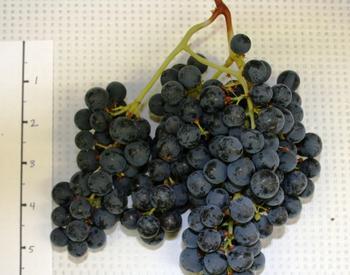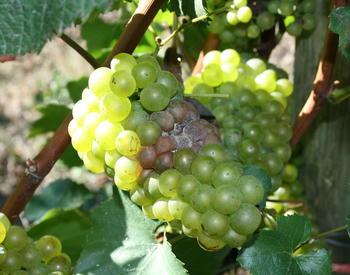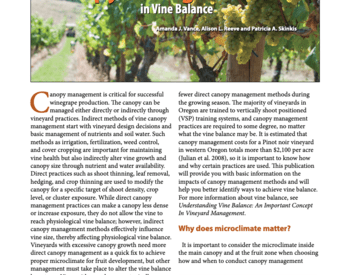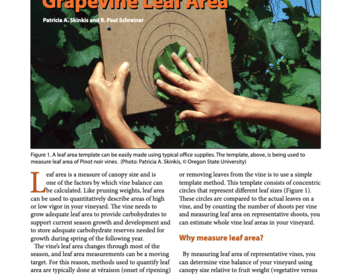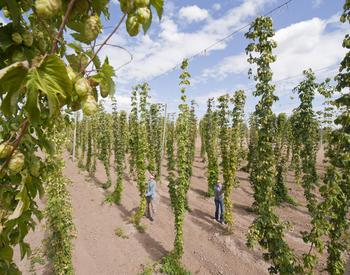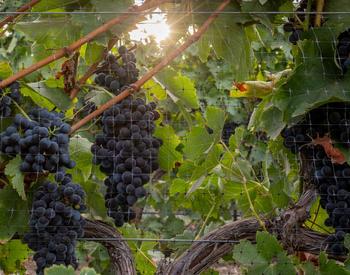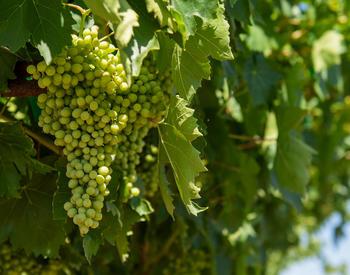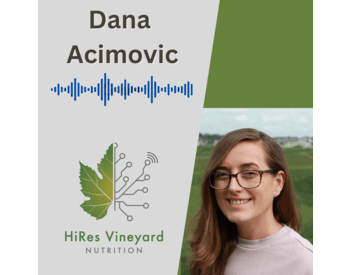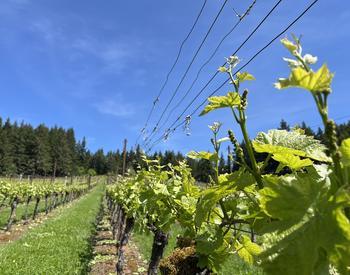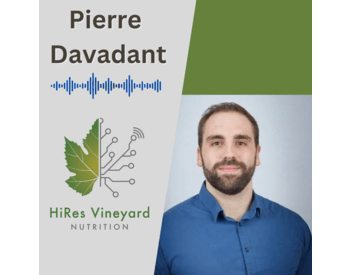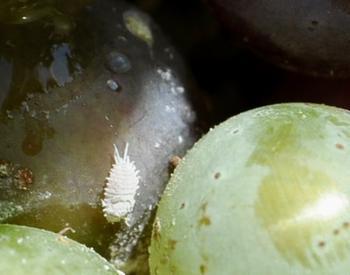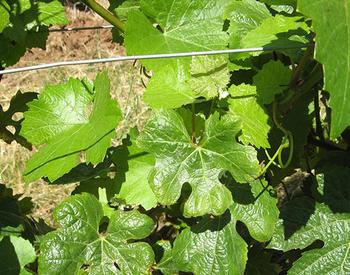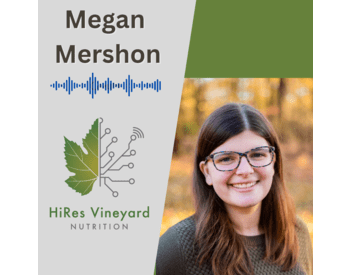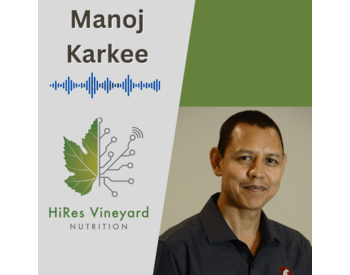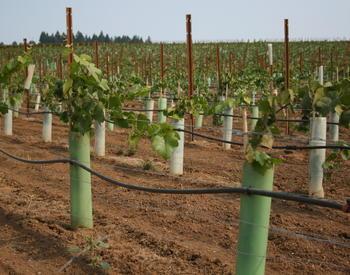Transcript
(00:00) Patty Skinkis
This is the High-Res Vineyard Nutrition Podcast series, devoted to helping the grape and wine industry understand more about how to monitor and manage vineyard health through grapevine nutrition research. I am your host, Dr. Patty Skinkis, Professor and Viticulture Extension Specialist at Oregon State University.
(00:22) Patty Skinkis
The costs of managing a productive vineyard are pretty high. We as researchers recognize this and we are often conducting applied research to address issues that relate directly to vineyard management practices that improve economics through increased productivity, reduced costs, and raising the quality of the fruit and all this hopefully will lead to higher return. The grape industry knows the real struggles of profitable farming and it's hard to find ways to cut costs, especially when we have rising labor costs as well as costs of supplies, fuel, and equipment. The HiRes Vineyard Nutrition Project was born out of the quest of the industry seeking better ways to identify specific nutrient issues and tackle them to improve the productivity and quality of grape products in the US. However, the ways we currently quantify vineyard nutrition are costly. Everybody knows we run out and grab tissue samples from vineyards and we do as much as we can. We send those off to analytical labs and those come at a cost. Typically, growers are trying to reduce their costs by reducing the number of samples they take, the number of samples that are sending they are sending to the lab, and ultimately, they are trying to make this work into their vineyard management budgets. In earlier episodes, we talked at length about these new tools or sensors that may help with getting more spatial data while also reducing the cost of analysis. While this is definitely going to have an economic impact if we are successful in getting a sensor and it's easily quantifiable, we wondered what other aspects of economics we could discern from the project. For example, are there nutrients that we really don't need to worry about because they don't have that much value at the end of the day for either grape quality or productivity? Or are there other nutrients that we're not focusing on enough? Often when we get our nutrient samples back, we're just focusing on fixing everything. We see if zinc is out of balance, we're going to fix that, as well as nitrogen, phosphorus, or whatever it might be, but perhaps that's not necessary. So that's what we've set out to do with the HiRes Vineyard Nutrition Project and specifically joining us today is Dr. John Woodill a research associate at Oregon State University and a colleague of mine in the social and economics focus group in the HiRes Vineyard Nutrition Project. Now, John is especially important to this project because his area of expertise is economics, but it's not just any economics. In fact, I see him as this rock star economist working in agriculture that has all of these multifaceted and multidisciplinary skills to work with economics, within the context of environmental landscapes from forest to fisheries, and in agriculture at the intersection of climate change. He has multiple degrees in economics including a B.A. from San Diego State University and a Master's and PhD from the University of Hawaii Manoa. He has numerous publications including production economics of managing coffee berry borer in Hawaii and other work with Hawaiian coffee producers which oftentimes lends itself really well to working with grape growers. Currently, he is a member of the Socio-Environmental Analysis Lab at Oregon State University where they examine climate and data models to address topical issues facing the ocean fishing industry. Now, where does that fit with vineyard nutrition? Well, he's got this multifaceted skill set of data analytics, economics, and agriculture that make him a critical player in the project, and he's helping us discern the impacts of nutrient management on growers’ bottom line. Thanks for joining us!
(04:01) John Woodill
That's great. Thanks, Patty, very happy to be here. Thanks for having me.
(04:03) Patty Skinkis
So, one of the biggest questions a lot of applied researchers have in production agriculture is how do we show environmental impact? We know a lot of what we're doing and what we're doing is driven by having that economic impact for growers, but you bring a very important aspect to this project and a unique skill set in determining the economics of both agricultural production data and climate data, and as a viticulturist as a horticulturist, this is puzzling to me is how to accomplish this. I'm sure for our listeners this is also difficult to understand, so can you define cconometrics for us and describe some of what your work entails?
(04:48) John Woodill
Yeah, absolutely. I can certainly understand it's a puzzling sort of idea and the word sort of econometrics sort of gleans this complicated thing, but it's really just about how economists use statistics to understand problems and we try to understand how humans make decisions around these sorts of problems. So, econometrics very simply is, if I were to think about an experiment, let's take a vineyard for example, or where we have two different plots and we want to apply a treatment to one of those plots and then we have a control in the other plot. Then ultimately let's say you're just trying to you're trying to apply some thinning practice to the treatment and then the control gets no thinning practice, and so as an economist, I'm interested in what the implications of the yield output of that are. What happens at the end of the season, and this ultimately leads into sort of a price or the market value of your product that you're trying to take to the market and so. What I'm really describing here is just science. We're testing whether or not we treat, how that difference between the control and the treatment is, but economists would take it just a bit into a different realm, where we try and think about the human dimension of that how humans make these decisions. Humans are really complex and not everybody follows the same pattern, and some act rationally, and some act irrationally, and there's just this complexity of the human dimension that makes these sorts of challenges really hard. That’s essentially what economics and econometrics is about. You hear the phrase, you know, “correlation does not equal causation”, well, econometrics is very much about trying to disentangle that correlation and identify the causal impacts. So that's just sort of on the yield plot side, but you had mentioned the weather, and the weather is a much more complicated thing because we can't control the weather. We have no ability to affect our plot with the weather. We can control things like irrigation and nitrogen uptake, but the weather is really something that's a random event that happens. You know this weekend, it was warmer in Newport, I live in Newport it was warmer in Newport than it was in Portland. It was in the 90s, it was really nice here. Never happens. So, this is sort of a random weather event, and you sort of think about how that affects human decisions from this random event. We can't control the weather, but we observe what happens when the weather changes and we try to understand how those decisions are made. So, it's just a long winded way of saying that econometrics is really about trying to disentangle that causal understanding of human decision-making. Environmental economics provides that natural experiment in order to identify those causal impacts.
(07:32) Patty Skinkis
So, when looking at the environmental aspects, of course, you're looking typically backward, correct? Looking at past events of climate rather than looking or projecting to the future.
(07:40) John Woodill
Yeah, exactly, and that's a challenging aspect because we know the weather changes. We can look at weather forecasts and know what's coming up and NOAA produces some really nice weather forecasts. But yeah, you’re, absolutely, right. We're really looking at past events and how those past events have impacted different yields. You know from year to year the weather changes and so you can't just assume this year is going to be the same as next year or last year so, you really have to try to identify those changes from year to year. Then you can sort of look at the whole aggregate of say a 10-year or a 20-year cycle to understand how the decisions have changed based on past weather events which then allows us to inform what happens in the next year, say if one of these events were to occur.
(08:22) Patty Skinkis
So, tell us a little bit about the research, the specific research you're doing in the HiRes Vineyard Nutrition Project.
(08:29) John Woodill
Yeah, absolutely. So, this kind of leans to what I was just sort of talking about. There’re two basic elements that I'm looking for. I'm not necessarily collecting the data in this regard. We're sort of leaning on other researchers in the project to collect the data for us to do analysis on, but we're really looking to identify how various nutrients, such as nitrogen and different quality metrics, affect the end-of-season yield. We are trying to collect data to inform that. When I say yield I should be clear and say that I'm thinking about sort of pounds per acre or pounds per kilogram, a way of sort of understanding an end-of-season prediction on the yield. So, we have nutrient data, we have quality data, but we're also incorporating weather data into this as well. Oregon State University has really nice weather data that comes out of PRISM and it's just this nice, gridded data, so we can get it really close to where the vineyard is [located] and collect that data. So, part of my more recent work has been looking to try and disentangle these effects between nitrogen, quality, and the environment. We've got a paper that we're hoping to get out real soon that looks at these, and then we're also going to hopefully develop some tools to help some farm-level decision support. You can imagine, somebody could go and look at the sort of data we've collected and they can input what their nitrogen levels, are/or quality, or what their weather is doing year to year, and understand what the yield impacts of that will be. And so, you know we're working on a bunch of different things. But really, it's the core of trying to understand nutrient uptake, quality, and weather and how those interact with one another.
(10:19) Patty Skinkis
So, this is where I want to just let the audience know, that one of the largest datasets that John is working on happens to be one of the projects that many growers are aware of, it's the Statewide Crop Load Project, which was conducted by my lab and with a host of twenty different collaborators within the Oregon industry; and we collected nutrient data. So veraison time point leaf blade and petiole samples that are paired with yield data and fruit composition data that we're able to use from a 10-year span of the project. That's kind of the baseline of what's been what we've gathered, and I believe there are other collaborators that have submitted data sets to work on that you're also able to use from that project.
(11:03) John Woodill
Yeah, exactly, and the data set that we're utilizing is really great because a lot of times we don't get time series, we don't get year-to-year changes, we only get maybe one or two years. And this data set that you describe is 10 years of data which is amazing. That allows us to look at a decade of nutrient changes and weather as opposed to just from year to year. So, it's an amazing data set for doing this work and we're really, we're getting some really nice results out of it.
(11:30) Patty Skinkis
So, one of the things that you brought up is that we're focusing on nitrogen first. Can you talk about why we're focusing on nitrogen? I can also add to that a little bit.
(11:40) John Woodill
Yeah, so, I don't know too much about wine, I'm an economist--I’m an environmental economist. I've brewed bucket wine before, but nothing to this extreme. And so, come to find out that nitrogen is a super important nutrient for vineyard management and to try to understand how changes in nutrient increases in nitrogen impact on the yield. So, we've really focused on three main nutrients. So nitrogen being the top but also phosphorus and potassium. We've used our econometric framework to try and identify what those marginal impacts are. So, if you were to increase your nitrogen levels at a certain point during the season, what does, what is that impact at the end of the year going to be? So, you can imagine that other vineyards are applying different nitrogen levels and we're trying to understand what that marginal impact is. So, if you were to increase that nitrogen level, how does that change? So, I've come to learn through this project that nitrogen is a super important nutrient for trying to understand yield management.
(12:47) Patty Skinkis
Absolutely, and that's from the larger scale of the project from other collaborators, that's also one of the things we know is nitrogen is driving growth, driving fruit composition as well, and of course, we've got all that information included in our data set. So, the next question: one of the things that we often struggle with is, you know, we have a hard time quantifying the impacts of our research on an economics level, both at the industrial scale but also at the farm scale and often because data are missing on either production costs that are due to the producer not having firm numbers from their operation or the inability to share those data with us. How do you come up with your economic models given the lack of that kind of concrete data from growers directly?
(13:36) John Woodill
Yeah, that's exactly right. We struggle to find production costs in our data-collecting efforts. So, it usually is one of the limitations of our economic frameworks. So, if you're trying to opt up, as a vineyard manager or a farmer, you're trying to optimize profit and profit is: you take your revenue, which is how much you produce, you multiply it by a price, that’s your revenue and then you have cost. Cost is how much you produce, how much does that cost per se pound cost and you difference that out and that's your take home at the end of the year. Revenue is pretty easy: you get to the end of the season, you harvest, you weigh it and then, depending on what you do with it, you can usually derive a market price from that. You multiply p (the price) times the quantity and that’s your revenue. But costs are really difficult because they incorporate a lot of different things. They include things like rent and taxes and maintenance and repairs and vineyard management and labor and operation management. There's a whole variety of things and this is a difficult collection task for really anybody, but more or less, vineyards manager or farmer who's busy dealing with the fields, not necessarily collecting the data. So, this sort of partitioning these things into these different buckets makes it really difficult to try and figure out the cost. So, how do we overcome that? Well, one way is we generally focus on revenue and we just assume that there's sort of a fixed cost, that is for each pound that's produced. We can lean into the experts in the field to say hey this is sort of about what it costs to produce this many pounds of grapes or whatever you know, so we can sort of lean on that. But in general, what we're trying to do is we can sort of use revenue as the driving factor assuming that that's ultimately what you're after is the end-of-season revenue, and then you can difference out the cost. And that's also to say that--just a plug-- we would love to talk to anybody that maybe has some cost data that they'd be willing to share and talk to us to try to inform our models. We've reached out to the industry to try and get this as I'd mentioned but, efforts haven't been as productive as we hope. So, if anybody has some data they'd love to share or talk with me about, I'd love to open the invitation to that.
(15:55) Patty Skinkis
That's great. I think that also helps the industry to understand a little bit about when we're talking about our economic impacts specifically it's on the revenue end, and I'm glad to hear you confirm that because that's how we do it generally when we don't have economists like yourself included on a project, we do those rough you know back the napkin calculations based on the best knowledge that we have.
(16:18) John Woodill
It was a big limitation to coffee farms as well. When I was working with coffee farmers. It was sort of the same thing and that's, it's just the nature of operations. It's understandable and we try and do the best we can with the data they were collecting, and it still does inform; revenue still does give us a general sense of what's going on at the field level, even if we don't incorporate costs.
(16:41) Patty Skinkis
So, what is the most challenging thing that you deal with in your research?
(17:18.79) John Woodill
It's data. Data is one of the more challenging things. You know, probably 80% of my work is data collection, data cleaning, and data processing, and then modeling is a very small percentage of it. That's kind of the easy part [modeling]. Honestly, it's really the data you know, outside of the HiRes wine work I do, I deal with big data I deal with hundreds of thousands, millions even billions of data points sometimes. I use satellite data from NASA to infer different environmental models in our oceans. So, the main limitation there is just processing the data. It takes a lot of processing power to process that much data. But when you're dealing with agriculture vineyard data, you don't get a lot of observations in the year. If you get 12 per year I think that's very hopeful. You may only get, you know, pre-bloom and at harvest or these sorts of data. So, you're dealing with much smaller datasets. That's sort of the challenge. We have to understand what our data is saying. But there's also a tradeoff here that I think's important to say is that big data is good because our models love big data. They need a lot of data. So, that's really easy from that. But big data is more of a big-picture idea. It gets into macro; it doesn't really get at the micro and so the field level data that that we're collecting is really important because it allows you to zoom in on the field. I think that's a much more interesting result, but it does make things much more difficult because we have to be more careful about the data collection efforts. We have to validate that the data is accurate because we have such small samples. You know, we're constantly cleaning the dataset that we're working with trying to fill in missing values and understand these different things and so there's a little bit more... I don't spend more time cleaning the data, I spend more time trying to understand the data from experts and you know observers and this sort of thing. So, data is certainly one of the more challenging aspects of the job. But it's also what I love to do so, it's really nice to see, it’s nice to allow the data to talk to you and tell you what's going on and I find that very interesting, although it is challenging.
(19:11) Patty Skinkis
So, I'm happy to hear that data is, that's what I figured you might say, given that you and I have worked together with having a student this summer who basically has worked for the last six months and most of what he's been doing, he's been doing some modeling but he's been doing a lot of data cleaning and filling gaps and it's mind-boggling that, he tells me every day. It's like there's so much data there. There's so much data there.
(19:37) John Woodill
And there's so much other data we could be collecting and doing but you have to cut it off at some point and say this is what this is what we're doing. It's yeah, he's been doing six months of data cleaning and that's, you know that's my job too. I clean data all day. So, it is very challenging. It's challenging too because you got to make sure that the steps that you're making to clean the data are accurate. You make a mistake and all of a sudden, your results don't make any sense. You know there was a divided by a hundred instead of a thousand and then the whole thing's blown up. So, it is very challenging but, the best part is it once you get the data done and cleaned and verified then you throw it into the model and then you get to see the fruits of your labor and that's just to me, that's very satisfying.
(20:20) Patty Skinkis
Yeah, absolutely. Having been able to be looking at some models for this project, I think it is very exciting and we can't wait to share more of that with you. So, you kind of talked about this a little bit already but, what is the most interesting thing about your research?
(20:38) John Woodill
Yeah, so, I hit on the data and the modeling. But really if you zoom out you know I'm an environmental and economist by trade and I really sort of so love understanding how people make decisions about the environment around them. We live in this human condition that is, we live in this environment that is constantly changing and we have to make decisions about what those adjustments make. Is it raining? Is it sunny? It’s 90 degrees here this weekend in Newport and I put shorts on which I hardly ever do and went down the sat on the beach, which I hardly ever do, and watched the surf competition which I hardly ever do. And it was great. But it makes you sort of think about how those environmental factors impact human decisions and this was a nice weekend, but there were also a lot of fires and smoke. So, while it was sort of positive for me, there are a lot of negative impacts that occur from this as well, in the environment that we live in. So, I find it just super interesting to try and understand how people make decisions about their surrounding environments and especially sort of the weather and the climate. And then, you know, you zoom in to a field of a vineyard: and how do these farmers make decisions with these environments. You know they may have been there 20 to 30 years; they have way more on-the-ground knowledge than I would look at data. So, it's just interesting to see how people think about the decisions, or how they make decisions based on the environmental patterns that they live in and they're completely random events and I just find that super interesting.
(22:19) Patty Skinkis
So, I think a lot of what you're talking about brings up a question that I think a lot of people listening to the podcast might wonder about and that's you know about that grape grower who knows their vineyards that knows the properties they're on. They know what it takes to produce a good quality product and then they're told by their accountant that they have to change what they're doing and meet a mark that's really not possible. So, how do you think your work can help kind of bridge that gap between that accountant that doesn't have that knowledge and the person who knows the production knowledge within a company?
(22:58) John Woodill
Yeah, and this is certainly something that I've thought a lot about especially working with coffee farmers and now we're working in the vineyard you know I don't want to be in a position to tell somebody what to do, I want to give them the information allow them to make the decisions that they think are best. So, you know we're developing these models and they give us these results and you know we display these results and they say, oh if you apply this most nitrogen at this point in the day, and if your temperatures at this point and this is sort of an optimal environment and this is going to be the best way to impact your end of the season yield. I sort of see it more as a data sharing thing like this is what I found, this is what I think is important and I think that this could really help you, but I don't ever want to be in a position that or tell somebody what to do. Information should be free. It should be available to people to make the best decisions that they can and that's really sort of how I think about my work is, I'm just trying to offer what I find and allow people to sort of make the decisions that are best for them.
(24:02) Patty Skinkis
Absolutely. I think that probably dove-tails a little bit with what you talked about: an app that would be available to people at the end of the project. Can you talk about that a little bit more, what that might look like?
(24:15) John Woodill
Yeah, sure. Well, we've actually sort of started to prototype this a little bit given the modeling efforts that we've already undertaken but you can imagine a website that you can go to that has a variety of fields you could put in: your address, your location or county and you could get weather information and you could get you to know evapotranspiration or precipitation. If you were trying to understand sort of these different simulations, like what if I apply nitrogen at this point in the year, or at this point, or these different nutrient levels, or different harvesting practices, or different thinning practices? What is the sort of ultimate yield estimate at the end of the year? So, I'm sort of imagining this sort of tool that will allow you to make these changes to understand how the end-of-year yield impacts will be based on those decisions without actually having to do anything in the field. So, there's this simulation that we can play with, but also to try and find out where maybe you are in other people's data like where is your nitrogen level compared to others in the project, or what is your weather? How much precipitation did you get as opposed to everybody else in this region or Oregon or wherever you are? It's really just about devising these tools that give you or give the user the ability to understand how these different decision points will change the end-of-season yield.
(25:40) Patty Skinkis
Excellent, I think many people will be looking forward to being able to try those things out in the future. So, now to wrap up, I want to ask you how you got into this specific area of study. Just for those listening out there, if they have any interest in going into econometrics or becoming an environmental economist. How did you get where you are today?
(26:06) John Woodill
Yeah, I've sort of had a winding path. I originally entered graduate school as a macroeconomist. Funny enough, I was playing with inflation rates and monetary policy and these sorts of things. I was looking for a research assistant position at the University of Hawaii, and I was given a position to work on Hawaii coffee. There was a pest that showed up a couple of years before I got there. It was doing really bad damage to the coffee bean, and so they gathered a group of economists to look at this issue to try and understand the economic damage. I was the graduate student that was working on cleaning the data and writing papers and so, so it was a little bit outside my field but I figured I give it a shot. And then I realized that when you go out to the coffee farms and you talk to farmers and you try and understand their processes, that's way different than sitting in a lab and cleaning data. You know, we would sit on their beautiful lanais and drink the freshest coffee and just sort of chat and understand what's going on. And it really put economics on the ground for me. It made me understand why, like the direct impact of economics and how that sort of plays out, and then from there, it just sort of grew and started looking at climate change impacts on agriculture. You know, economics is very much centered around econometrics, so there's a huge body of literature that devises all these models that allow us to sort of understand the environmental impacts. I just enjoy learning about new and exciting things and using economics as a basis to try to understand those things. You know I would say if anybody's interested in sort of trying to understand this I'd be happy to answer any questions or reach out but just get involved in a project that you find interesting that has a little bit of economics in it. It just hooked me right away. It just, it's an interesting way to look at the world and it just gives me a lot of tools to try to understand that.
(28:13) Patty Skinkis
Very cool. So, can you also tell us how many different crops have you worked with and what production systems for economics?
(28:20) John Woodill
So, the sort of micro level, Hawaii coffee mainly in Kona, and then the vineyards here in Oregon. But I've also done some economic climate change works on a lot of our field crops in the Midwest, so corn, cotton, hay, soybean, and wheat to try to understand those economic impacts and maybe where the land shifts are going to occur or what the damage to yields are going to be. So, I’m not as familiar with those because those are more macro level. I'm more familiar with sort of micro-level coffee and wine grapes. But yeah, so I've gone from Hawaii over to the Midwest across a variety of different crops.
(28:59) Patty Skinkis
Is there any commonality you see, if there is any, across looking at those data that you could kind of comment on?
(29:07) John Woodill
You know, it's so interesting that I see a lot of similarities between coffee and wine grapes. It's from the farmer's perspective, you know, a lot of them are vertically integrated. They're growing their own wine producing their own wine and selling it at the market and that's what coffee farmers are like as well. They're very tuned to their farm management practices because their fields aren't as large as say the big crops like corn and wheat. So, they're much more on the ground understanding about what's going on in their field which is just great to talk to them about. The environments are a little different, but I think that you know you don't need a lot of irrigation for coffee. You don't need a lot of irrigation for wine grapes [in Oregon]. You know it's ah, there are some similarities that I think are interesting between the two even though they're in completely different climates.
(29:59) Patty Skinkis
Well, thank you so much for joining us today, John, and thanks for sharing information about your research, I'm sure that we'll have some more exciting information coming up pretty soon. To learn more about the HiRes Vineyard Nutrition Project see our website at highresvineyardnutrition.com and follow us on Twitter, Linkedin, and Instagram.
Economic sustainability is important to all farm operations. How do we determine economic value of nutrient management in the context of the vineyard production system or into the future? Dr. John Woodill, Research Associate at Oregon State University’s College of Earth, Ocean, and Atmospheric Sciences, describes how econometric research explores farm production, yield, and climate data to understand the impact of mineral nutrition through models developed from and informed by that data.
